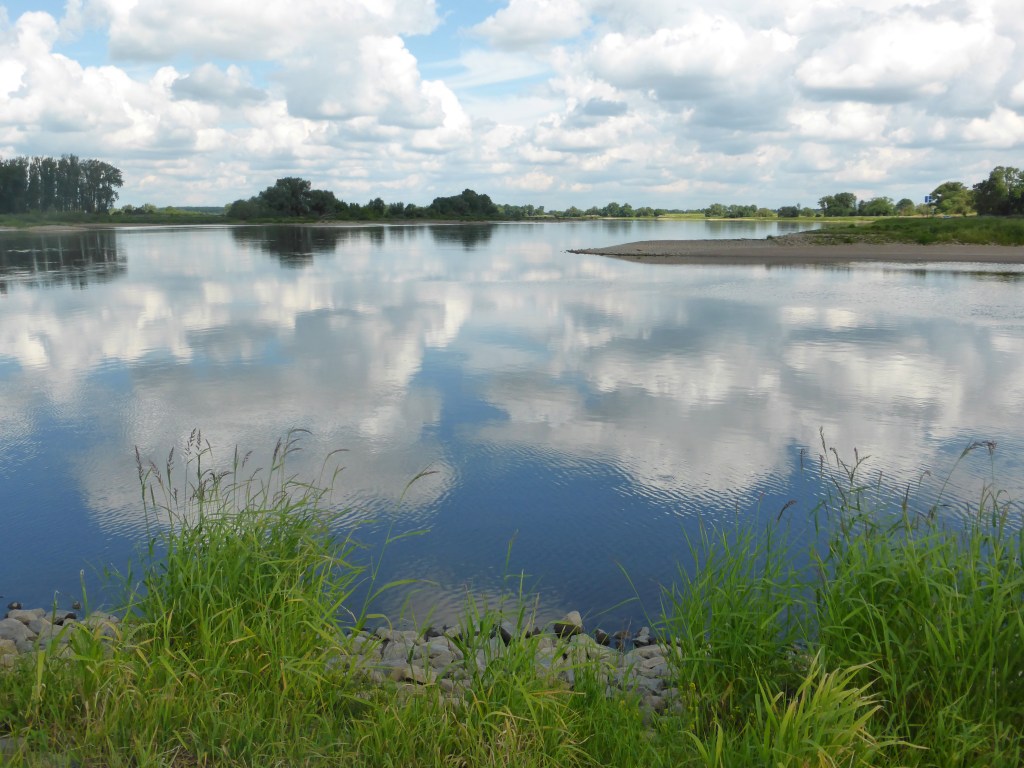
This year we explored the River Elbe from Dresden in the south-east of Germany to Cuxhaven in the north. Following this long river in our campervan turned out to be a fantastic way to be both focused and relaxed on a trip. We explored so many attractive towns and cities and spent days cycling and walking through glorious nature reserves. The Elbe took us to parts of Germany we might not otherwise have reached and broadened my knowledge about this fascinating country.
I first travelled along the banks of the River Elbe in 1992. We arrived on the overnight train from Köln, changing in Dresden for a train to Prague. While our six-year old son charmed the other passengers in our compartment, shyly accepting sweets and drinks, I was enchanted by the river. The railway line follows the Elbe through the rugged narrow gorge of the Sächsische Schweiz, it was magical and I knew I would return. Roll forward a few years and our summer holiday began with a ferry from Harwich to Hamburg. This time I was on [rather than alongside] the River Elbe and I stood on deck as we chugged along the wide river into the massive port of Hamburg. This has to be up there as one of the best ferry trips I have ever taken, it is a shame it no longer exists.
The River Elbe is 1,094 km long. It rises in the Czechia mountains that border Poland, winds through Czechia until it eventually settles on heading north and crossing the border into Germany. After Dresden and Meissen, the Elbe flows across the North German plain towards the North Sea. The cities of Wittenberg, Dessau and Magdeburg sit on the Elbe before you reach Hamburg. And yet, it is the pasture and marshes of the Elbe’s floodplain that characterise the river through much of its German journey.
For the most part the Elbe was either in the DDR [German Democratic Republic or East Germany] or formed the border between the DDR and West Germany from the end of the Second World War until 1989. The legacy of this is lush riverbanks of wildflower meadows, farmland and wetland wildlife reserves with dykes to try and stop flooding. These dykes are often well away from the river, giving it space to flood naturally while still [hopefully] protecting villages.
When I learnt that the Elbe [like many / most German rivers] has a cycle path alongside it, I bought the guidebooks and started planning. In 2020 [BC – Before Covid-19] I had a pile of guides and maps and notes galore from my research for a trip from the source of the Elbe to Cuxhaven and the North Sea. Of course, that didn’t happen and in this AC [After Covid-19] world and taking into account the high cost of diesel following the Russian invasion and war in Ukraine the trip became something simpler. We concentrated on the section of the Elbe from Dresden to Cuxhaven, saving a considerable amount in diesel.
We used the Bikeline Elbe Cycle Route Part One and Two guidebooks in English. Cicerone now produce an Elbe Cycle Path guide that I am sure is excellent. I also got hold of useful brochures from this website. In many places the cycle route runs on both sides of the river and this, and the many ferries [see the end of the post for more on ferries], made circular day rides easy to plan. We travelled up and down the Elbe for about four weeks, often only driving about 50 km between campsites. You could do the trip more quickly!
Maybe it was because we weren’t in a rush, or the flat landscape or the rural areas with less urban stop-start driving but our campervan gave us the best mileage per litre of diesel we have ever got from it [the equivalent of about 39mpg]. Maybe with about 65,000 miles on the clock our Renault Master is just run in! Either way, we only filled up four times in our whole seven-week trip and one of those was just to take advantage of slightly cheaper diesel!
The cycling was really the highlight of the Elbe and I would recommend the river to anyone who enjoys pedaling through flat green countryside, stopping in pretty towns and villages for a beer or an ice-cream. Below are brief overviews about some of the wonderful places we visited as inspiration for anyone considering a trip to Germany as well as a section about the Elbe ferries at the end. This previous post has the list of campsites we used.
Dresden
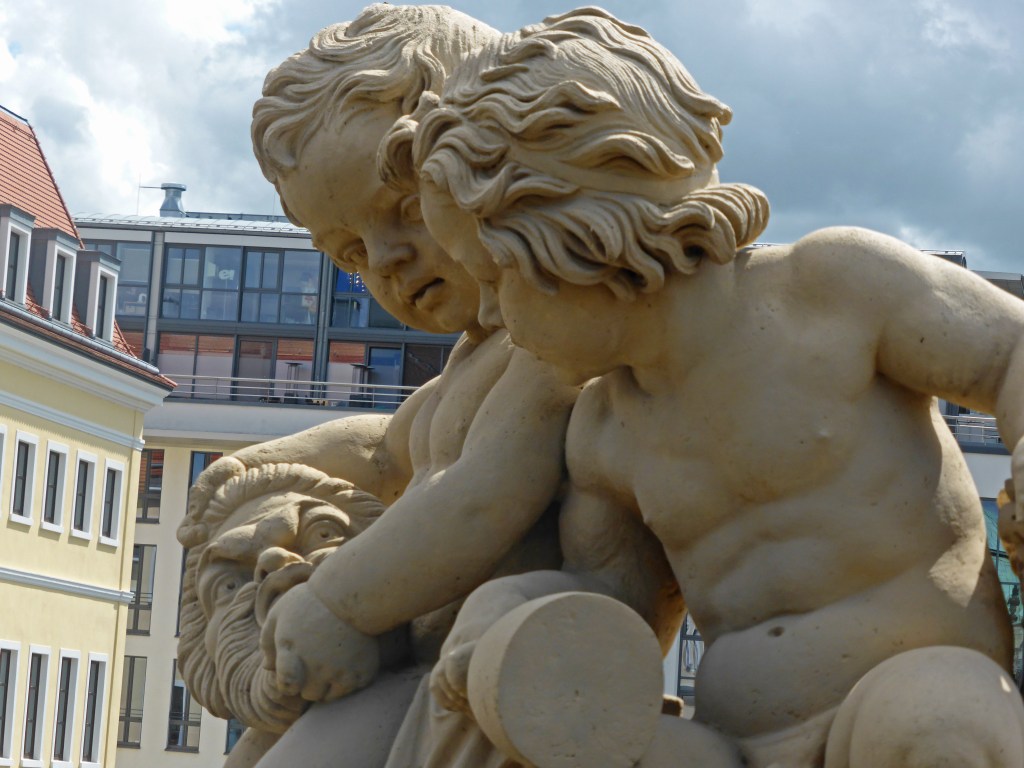
This city has changed since 1992 when the Frauenkirche was still a pile of rubble and the pedestrianised Prager Strasse a wide Soviet showpiece boulevard. Don’t miss the transformed Prager Strasse and a walk around the roof-top terrace of the late Baroque Zwinger Palace.
Meissen

Meissen is delightful and I should never have left visiting it for so long. The view of the town from the Elbe is spectacular, the streets are attractive and if you like up-market window shopping or sipping a glass of local wine in a pretty square then this is the place for you!
Mühlberg & surroundings
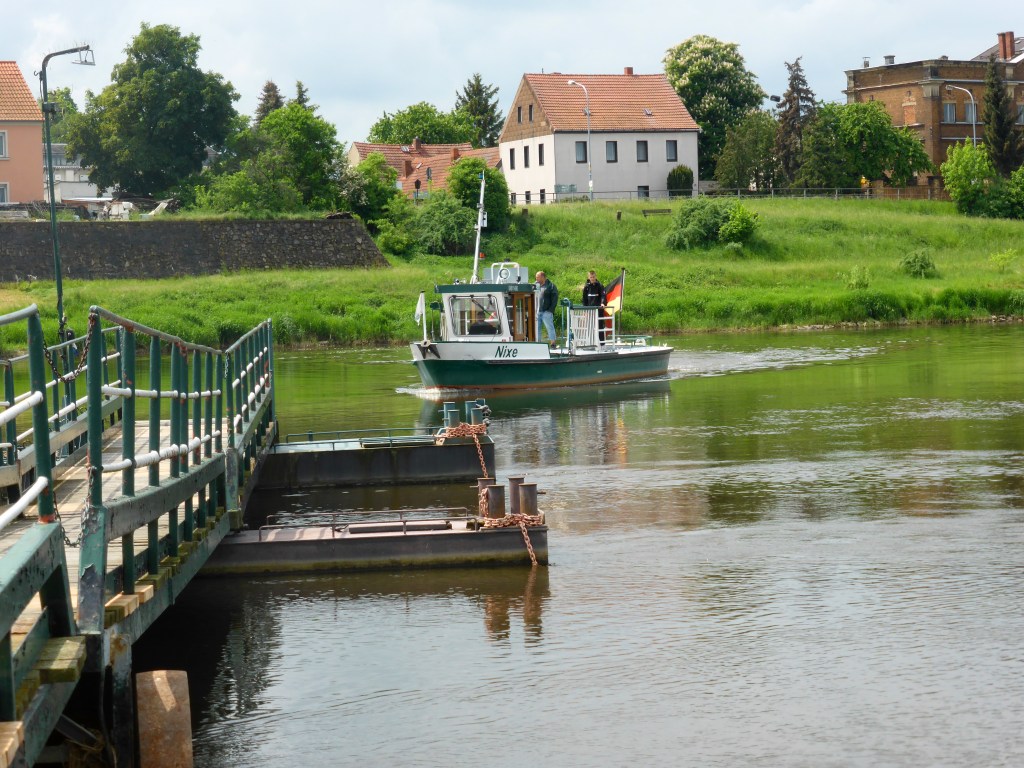
This sleepy little town surprised me. Mühlberg has a magnificent convent church, a pink town hall and other inviting corners along its cobbled streets. Our campsite pitch was idyllic and from Mühlberg we cycled up and down stream through a rural area that was packed with wildlife.
Torgau

Celebrated as the place where American and Russian forces met at the end of the Second World War this is an exceptionally attractive town with a striking castle and a big square that is perfect for people watching. The only thing that spoilt our visit was the heartbreaking sight of magnificent brown bears that are kept in the enclosed moat.
Wittenberg

Internationally known for its association with the Protestant reformation, Wittenberg is lovely enough to visit whether the activities of Martin Luther in 1517 interest you or not. The main streets, lined with open water channels that were once part of the Medieval water system, take you to a handsome square and the town has a ring of parks.
Wörlitz Park

On a sunny day a visit to the fairytale gardens of Wörlitz Park are hard to beat. Rowing boats slide under elegant wooden bridges, a flat-bottomed ferry crosses the lake from a kneeling Venus statue. Across lawns you catch glimpses of follies and peacocks potter around the Gothic House. I am not sure if it is real!
Oranienbaum

In the 17th century the Princess of Orange-Nassau chose to put her summer palace near to Wörlitz and insisted the village name be changed to Oranienbaum. Orange trees line the garden walks and the palace faces a square with a metal orange tree sculpture. Beyond this House of Orange symbolism there is an Chinese garden with a pagoda and a charming tea house.
Dessau

The Bauhaus art school was a radical movement that combined art, crafts and technology in 1920s Germany. The Bauhaus Building in Dessau is an icon of modern architecture and the innovative Master’s Houses, that can also be visited, are inspiring. I was thrilled to be there.
Magdeburg
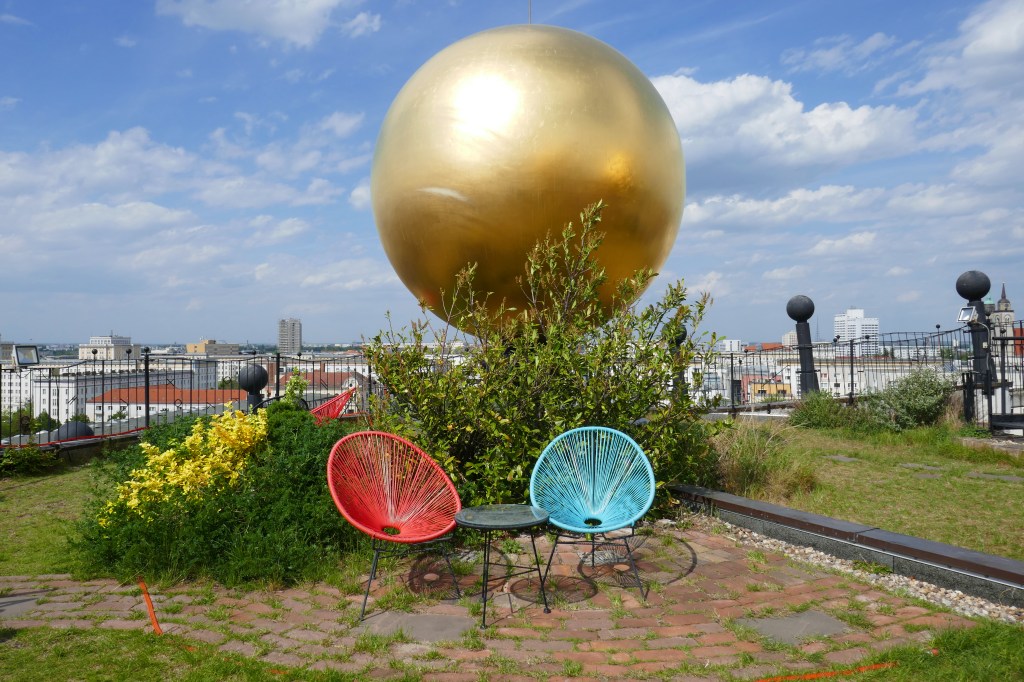
The city of Magdeburg is lively and energetic with many fine sights. For me the most inspiring was the last building the architect Hundertwasser designed, Die Grüne Zitadelle. Taking a tour around this amazing unsymmetrical structure with lush garden roofs is an opportunity to see a different future for city housing.
Around Jerichow

North of Magdeburg we spent a few days cycling through the woodland and flower-rich wetland meadows between Jerichow and Burg. Jerichow has a large and impressive brick-built monastery and the town of Burg retains some of its medieval fortified walls.
Tangermünde

We only spent a morning in Tangermünde but could easily have stayed longer. This historic town on the banks of the Elbe was at its height in the 15th century when it was a member of the Hanseatic League. Numerous brick Gothic buildings tell the story of the town’s wealth, along with the almost entirely preserved city walls and fortified gates. I want to return and stay in one of the town’s pretty timber-framed houses on its cobbled streets.
Havelberg & Werben

We cycled to the quaint town of Werben from Havelberg [on the River Havel where it joins the Elbe], taking the ferry across the Elbe. Werben celebrates its storks and has plenty of them. I felt privileged to get the chance to look down on tiny chicks in a stork’s nest from Werben’s gatehouse and tower.
Dömitz

The town of Dömitz has large star-shaped 17th century fort. The elbow-shaped defensive entrance tunnel proved useful for shelter in a hail storm. We watched the hail bounce off the cobbles while staying dry. From the fort’s remaining bastions there are views of the Elbe and the new road bridge. When the sun returned Dömitz was also the place to try DDR softeis [ice-cream].
Hitzacker
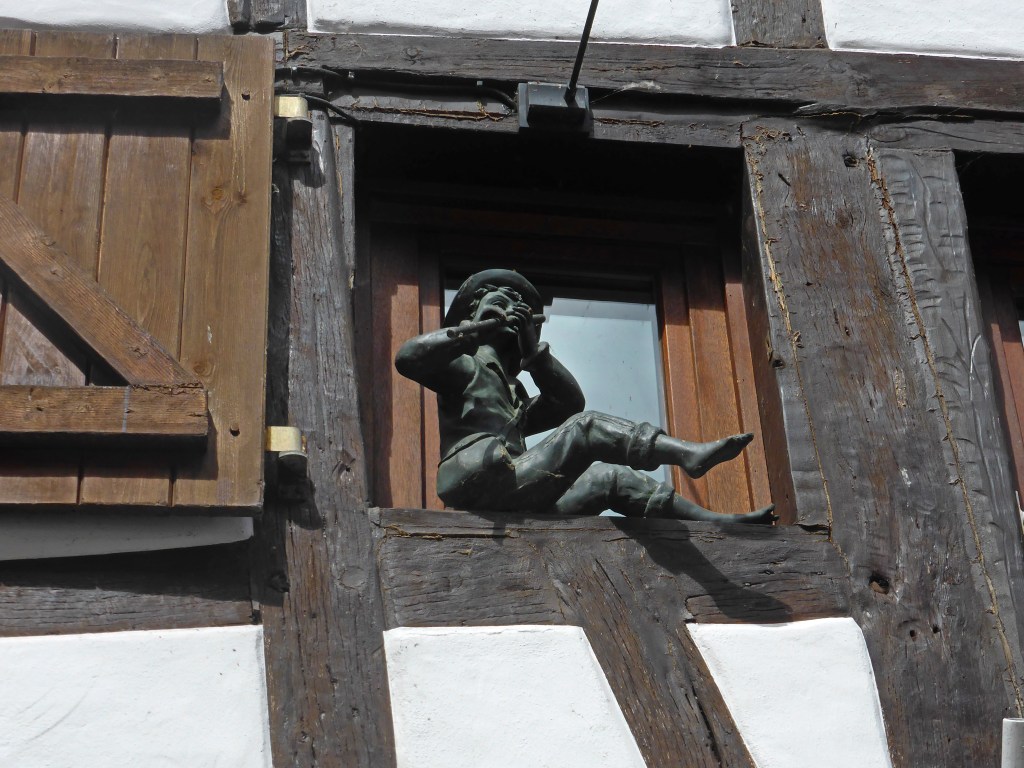
The picturesque island town of Hitzacker has a long history of tourism and it is still a popular place to visit with a car park big enough for motorhomes and an overnight parking area too. The small touristy town of timber-framed houses has plenty of places to eat and some interesting independent shops.
Around Lauenburg

We stayed a few nights on a campsite between Bleckede and Lauenburg and enjoyed some glorious days of cycling. In a country full of attractive towns, Lauenburg, strung along the bank of the Elbe, stands out for being particularly delightful. The countryside is green and dotted with handsome farmhouses and tidy villages. We were lucky enough to watch a barge being carried up the massive boat lift at Scharnebeck too.
Hamburg
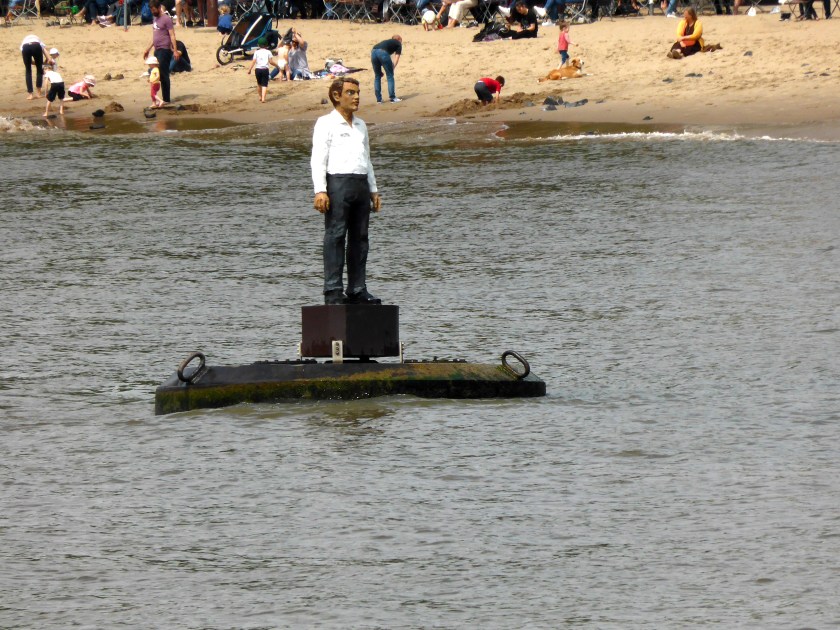
The Elbe is a busy shipping waterway by the time it reaches Hamburg, which might be my favourite German city [although there is lots of competition]. I find the huge container port fascinating, the city’s energy addictive and the number of beautiful historic sights captivating. We arrived by ferry from Finkenwerder and walked through the Old Elbe Tunnel under the river. If you’ve never been, put Hamburg on your list!
Stade

Across the Elbe from Hamburg is an area called the Altes Land. This large fruit-growing area is both wealthy and scenic. We cycled around the numerous orchards and spent a day in the town of Stade, pottering around the historic centre and visiting the open air museum learning about the symbolism of the decorative features on local buildings.
Cuxhaven

Cuxhaven is the end of the road for the River Elbe. Here the wide river is busy with shipping as it flows into the North Sea. Cuxhaven is a fishing town and seaside resort. Along the coast the sandy beaches are vast and you can hire a strandkorb, a covered seat for two, for protection from the wind.
Bridges and ferries
All of the Elbe ferries we used carried bikes and passengers, even the small ones, while larger ferries carried a few cars too. We paid between €3 and €5 to cross the river, the price seeming to have nothing to do with the width of the river!
Many Elbe bridges were destroyed during the Second World War by retreating German troops. With no need or desire to re-establish those connections across the Iron Curtain during the Cold War there are still a relative small number of bridges across the Elbe. Another factor is that the Elbe regularly floods and bridges need to be long enough to span the floodplain and have an elevation that can cope with high water. This makes them expensive to build!
At Neu Darchau, which found itself in West Germany after the Second World War, we came across a campaign to stop a new bridge across the Elbe. On the opposite bank is Darchau, which was in the DDR. The re-connection of the two villages when Tanja, the local ferry made the first trip in 1989, is remembered and celebrated. At the ferry slipway we read about the ferry, admired the lovingly-made model Tanja, and learnt why these small communities see no need for a proposed massive bridge across this green section of the Middle Elbe Reserve.


I would love to be a nomad, but my husband passed a few years ago and don’t want to do it alone, although I travel solo all of the time.
LikeLiked by 1 person
I travelled alone in my youth and know how lucky I am to have my partner to share my campervan travels with. You have had to cope with the grief of losing people you love and I admire your spirit. You have travelled to more countries than I will ever reach. Keep travelling and blogging and inspiring.
LikeLiked by 1 person
A very enjoyable read of your travels and the places you saw. Reminds me of our last trip into Germany, which we enjoyed far more than our previous one, as we explored along the borders with Germany & France. What is so nice is happening upon interesting, small, quiet towns en route & meeting friendly people on the stellplatz we stayed on. You visited so many interesting towns and cities & the lure of following a river is a strong one!
LikeLiked by 1 person
Thank you for your kind comments. Like you, I find that Germany is packed with interesting small towns. Each one is individual and beautiful. The area around the border with France is fantastic. I could probably spend all of my time exploring Germany but then other countries draw me in!
LikeLike